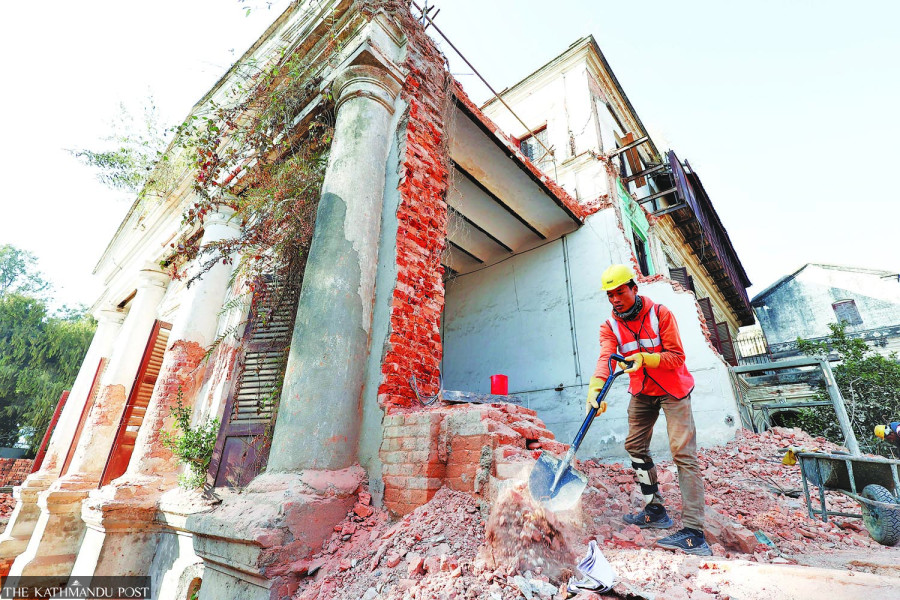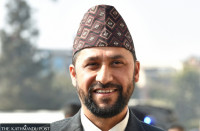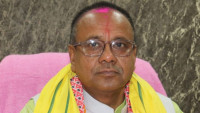National
Little progress in Nepal’s quake preparedness since 2015
New building codes have not been implemented and open spaces are in short supply.
Purushottam Poudel
The 7.8-magnitude earthquake that rocked Turkey and Syria earlier this week has killed over 24,000 people as of Saturday afternoon—and the death toll is still rising.
The jolts in Turkey and Syria bring to mind similar quakes Nepal witnessed on April 25 and May 12, 2015 that took the lives of around 9,000 and injured over 22,000. The 7.8m quake and its aftershocks destroyed or damaged over half a million houses and other structures, according to official data.
As the government’s post-disaster needs assessment (PDNA) report noted, Nepal is the 11th most earthquake-prone country in the world.
“Ever since the first recorded earthquake of 1255 AD that killed a third of the population of the Kathmandu Valley, including its King Abhaya Malla, Nepal has experienced a major earthquake every few generations,” the PDNA report read. The last great earthquake (of magnitude 8.4) in 1934 resulted in more than 10,000 deaths in the Kathmandu Valley, it further stated. There have since been earthquakes resulting in severe human and physical losses in 1980, 1988 and 2011.
Soon after the 2015 earthquakes, the Ministry of Federal Affairs and General Administration formulated the Town Development, Urban Planning and Basic Guidelines on Building Houses, 2015, aiming to reduce the number of casualties in future disasters.
But despite laws and criteria set in the aftermath of the quakes, the general people, the concerned authorities and the stakeholders have gradually forgotten their commitments over the years, experts say.
Amod Mani Dixit, president of the National Society for Earthquake Technology (NSET), an NGO working on earthquake preparedness, said that after the earthquakes, the government made decisions with potentially far-reaching impact—such as tightening building codes while building houses.
“But these decisions were never acted upon,” Dixit told the Post. “There is something wrong in the monitoring system of infrastructure buildings. But there has been no initiative to correct the faulty practice.”
Commemorating disasters is crucial too, Dixit said, adding that in many countries, governments set up museums featuring memorabilia of the disasters so as to remind people of such tumultuous periods and prod them to keep themselves in alert mode. “But in Nepal, the authorities pay no attention even to such serious matters,” he said.
Government officials, however, don’t buy Dixit’s arguments. Rudra Singh Tamang, spokesperson for the Ministry of Federal Affairs and General Administration, said the government has strictly implemented and complied with the recommended policies and the guidelines. Tamang said that the provincial governments have been delegated authority to implement the guidelines.
“Now the provincial level also has a system to determine standards related to building construction,” Tamang told the Post. “And they cannot be laxer than those fixed by the federal government.”
Tamang claimed that municipalities across the country are currently tearing down houses and other structures that violate the laws and building codes. He also said the government is fully implementing related policies.
But NSET President Dixit disagrees, insisting that the policies have not been followed properly.
Following the earthquake, the government underscored the need to maintain sufficient open spaces in cities and pledged to discover and promote them. Point number 7 of the standards enforced by the government has categorically mentioned the provision of maintaining open spaces.
It has stated that local units shall protect available public places and develop them as green parks.
Dixit gives an example: soon after the earthquakes, the government had decided to develop the public land situated at Bhainsepati in Lalitpur as open space. “But now, there are ministerial quarters built in the area,” Dixit said. “This shows that at least our state mechanism has not learned anything from the devastating earthquakes of 2015.”
During the 2015 earthquakes, Nepal Army played a leading role in rescue efforts and in managing displaced people. That same organisation has now constructed several buildings in open spaces where people from core Kathmandu gathered after the quakes. For example, people from Khichapokhari took shelter in the open space near Nepal Army Officer’s Club in front of Bagdurbar. But now the army has built huge structures in the same space.
Tamang indirectly acknowledged that the government has failed to comply with its own guidelines.
“After the earthquake, there was a discussion to keep open spaces intact while constructing buildings in urban areas, but there is also the question of availability of land in places like Kathmandu Valley,” Tamang said. “In some cases, buildings have been constructed on the basis of need.”
Open spaces become crucial during a natural disaster like an earthquake. The guidelines drafted in 2015 took note of this and gave priority to maintaining open spaces during building-construction. The guidelines also mentioned that commercial buildings cannot cover more than 50 percent of their land while residential buildings should only occupy 70 percent of the total land. But this building code isn’t followed, experts say.
Susan Vaidya, an architectural engineer and a promoter of Livable Kathmandu, said that in cities like Kathmandu and other urban areas where land prices are high, it is difficult to fully comply with the standards. “The government should bring more practical criteria,” Vaidya said.
If Nepal continues to ignore the past and does not prepare for future disasters, it is bound to incur huge losses from earthquakes, experts further say. Nepal sits atop a major tectonic plate boundary between India and Tibetan (Eurasia) where a collision between two plates is still in progress.
Monika Jha, chief of Nepal National Earthquake Monitoring and Research Centre, said a huge earthquake could strike Nepal at any time.
Nepal lies in one of the active continental collision zones of the world, Jha explained. The north-moving Indian plate collided with the Tibetan (Eurasian) plate around 50 million years ago. The Indian plate is still moving north at an average of about 4 cm a year relative to the Tibetan plate. Because of this, the rocks have been under continuous push and strain. When the strain energy exceeds the elastic limit of the rock, they break to generate earthquakes.
On July 31, 2022, a six-magnitude earthquake hit the eastern part of Nepal, with Khotang district as its epicentre. Lately, on November 9, 2022, an earthquake of 6.6 magnitudes hit the western part of Nepal, with its epicentre in the Doti district. It claimed the lives of six people and injured seven.
The jolts that occurred recently in western Nepal were not aftershocks, but fresh quakes, Jha said. “Nepal is prone to earthquakes and comparatively, the country’s western parts are more at risk,” she said.
However, according to Dixit, an earthquake can affect an area up to 1,000 kilometres from the epicentre, meaning that if there is a significant jolt anywhere in the country, Nepal as a whole could be affected.
The epicentre of the 1934 earthquake was in the eastern region of Nepal and its impact reached Kathmandu. The impact of 2015 earthquake, with the epicentre in Gorkha, reached Dolakha.
“It might be claimed that the western section of Nepal is more earthquake-prone than other regions, yet entire Nepal is at risk,” Dixit said. “We must be better prepared to tackle such disasters.”




 15.12°C Kathmandu
15.12°C Kathmandu















